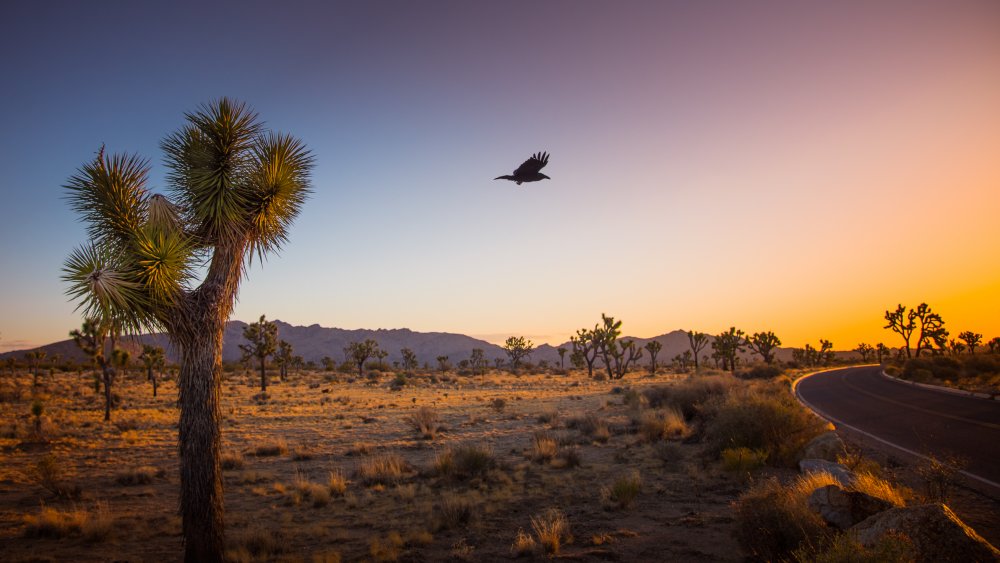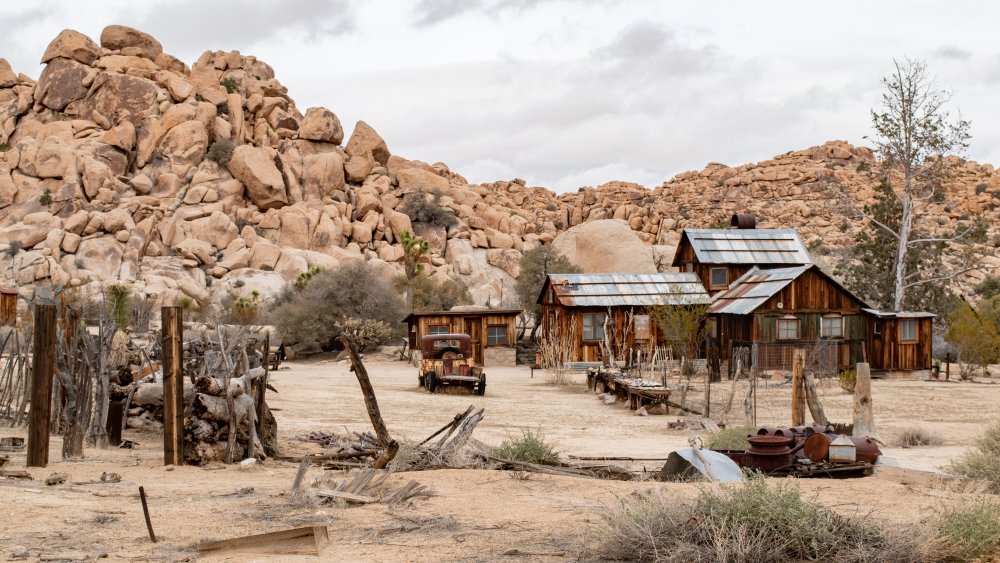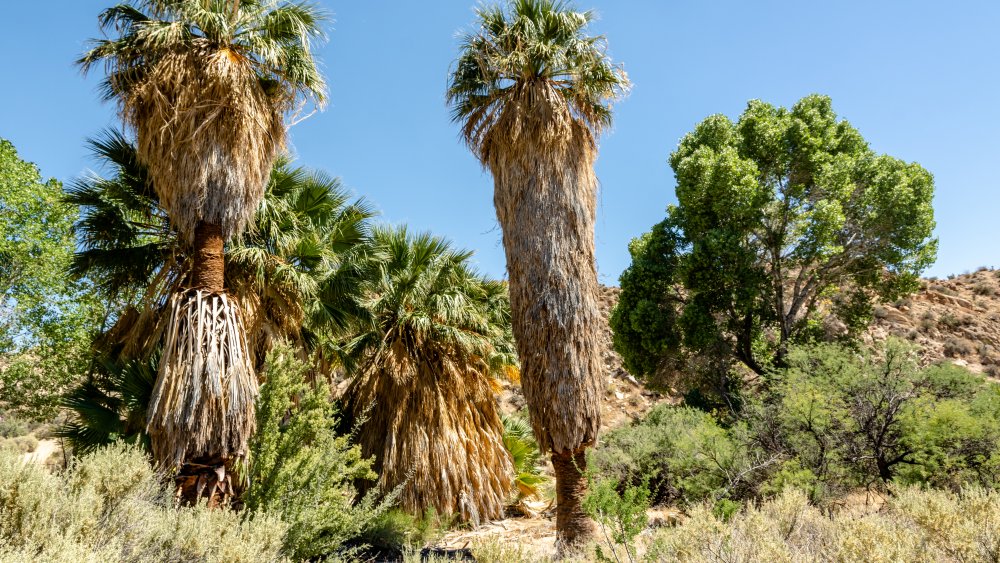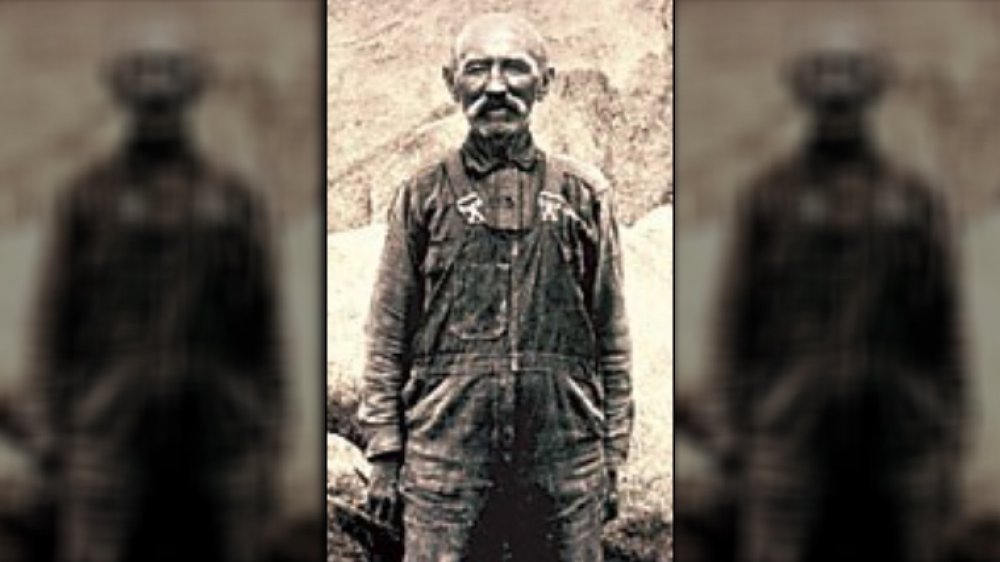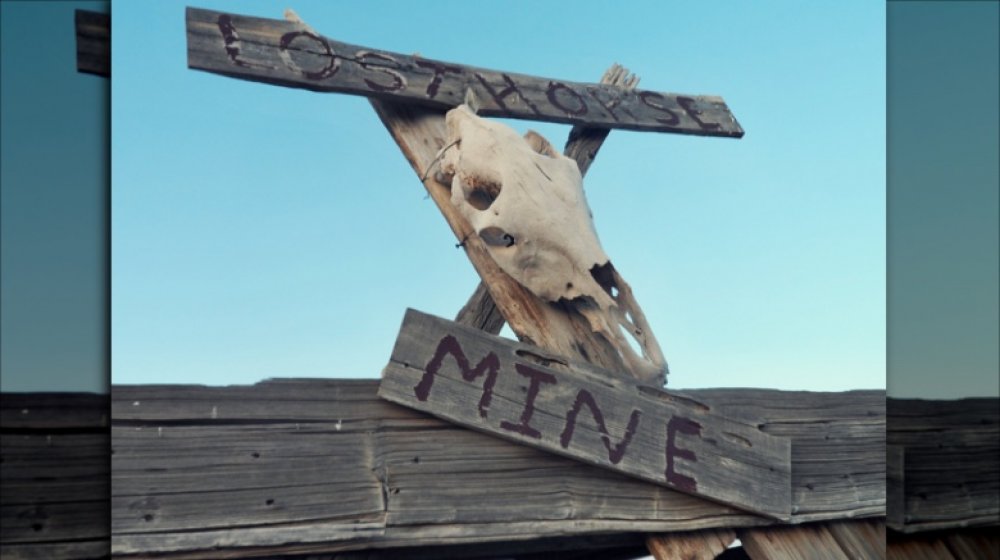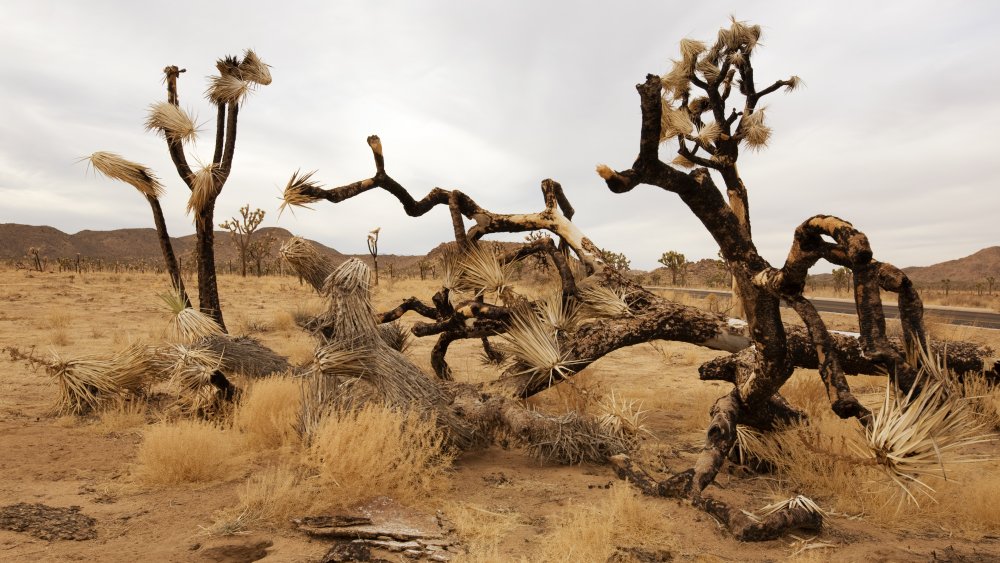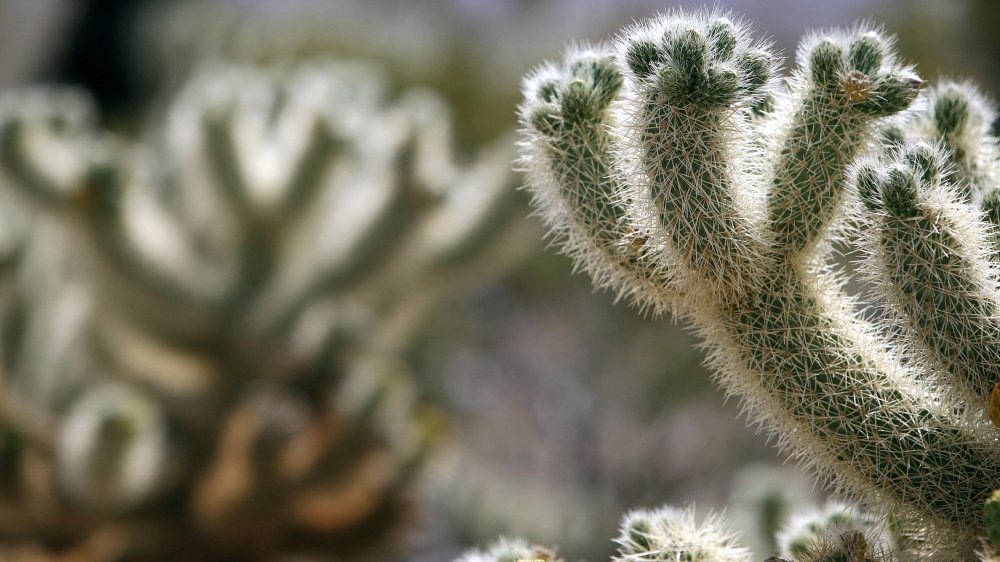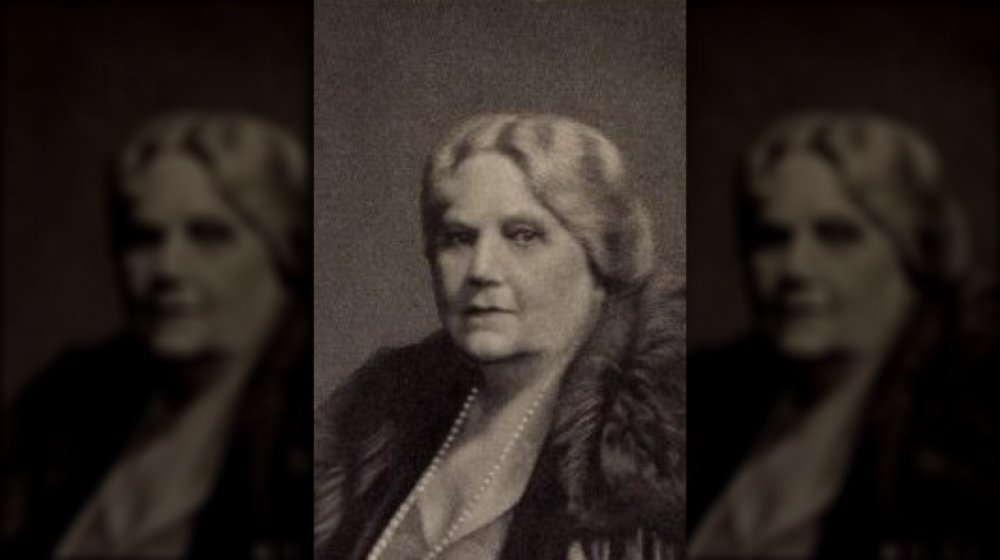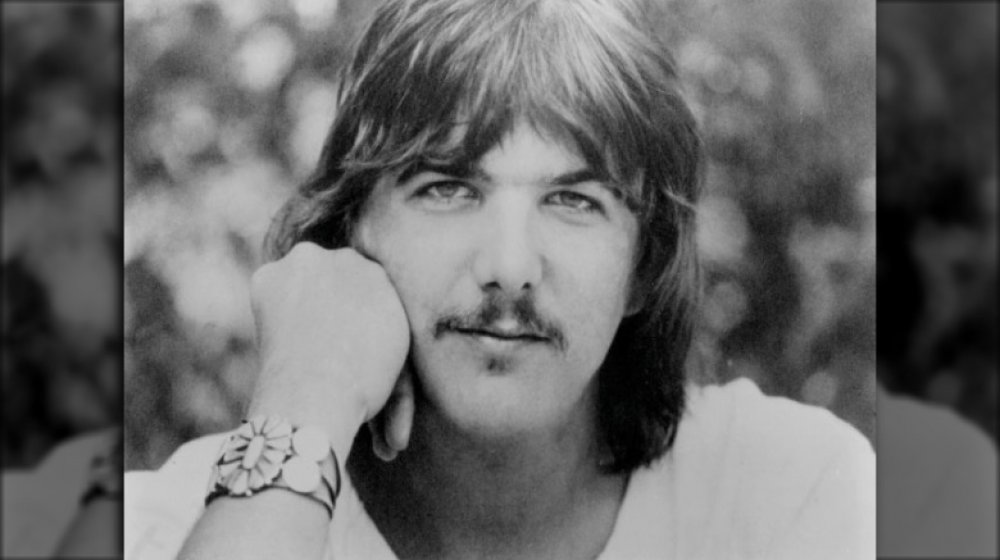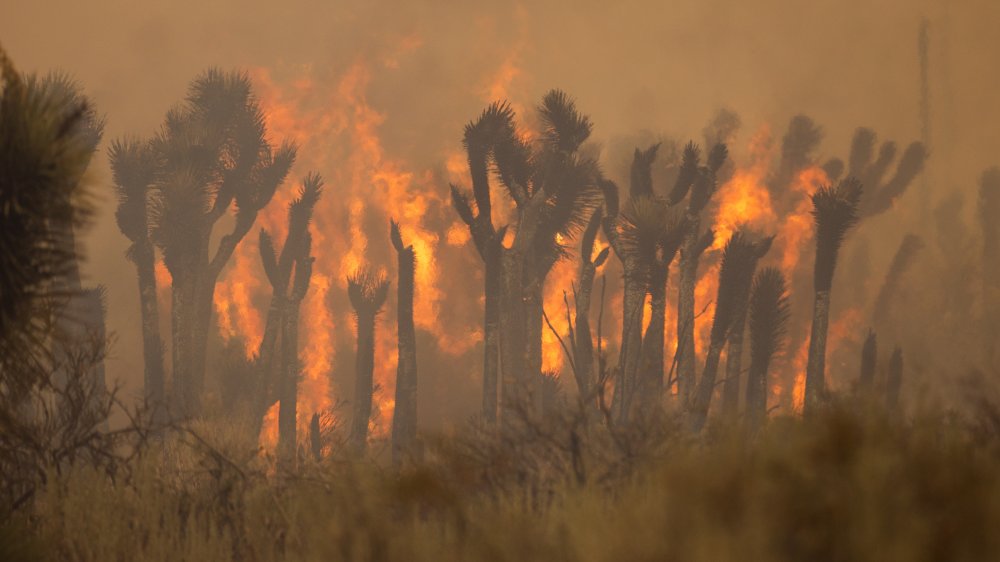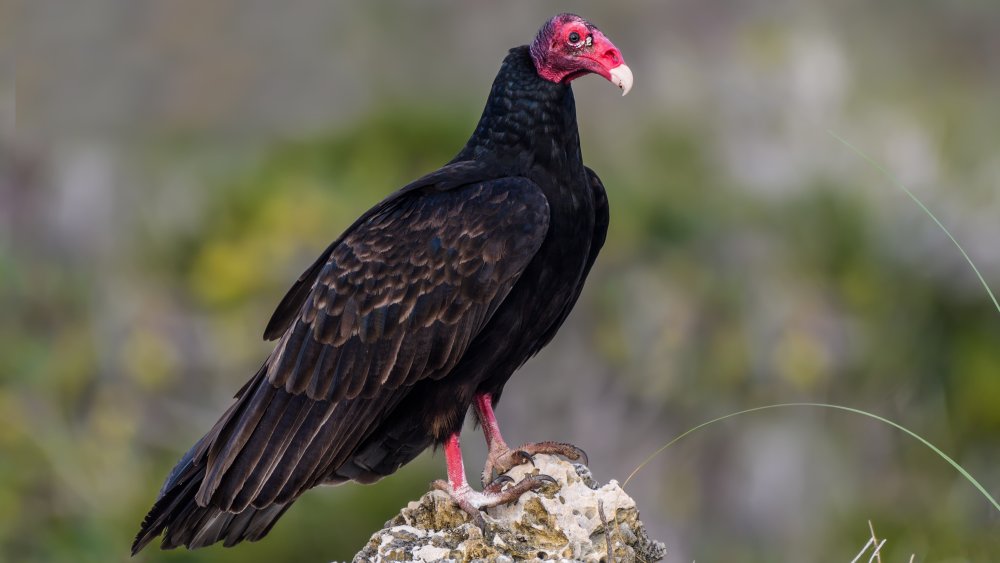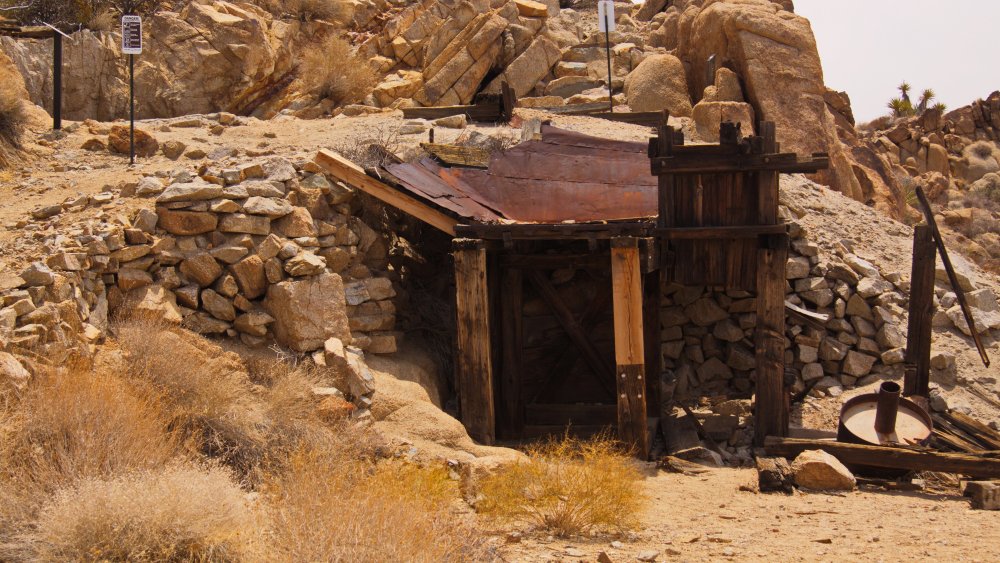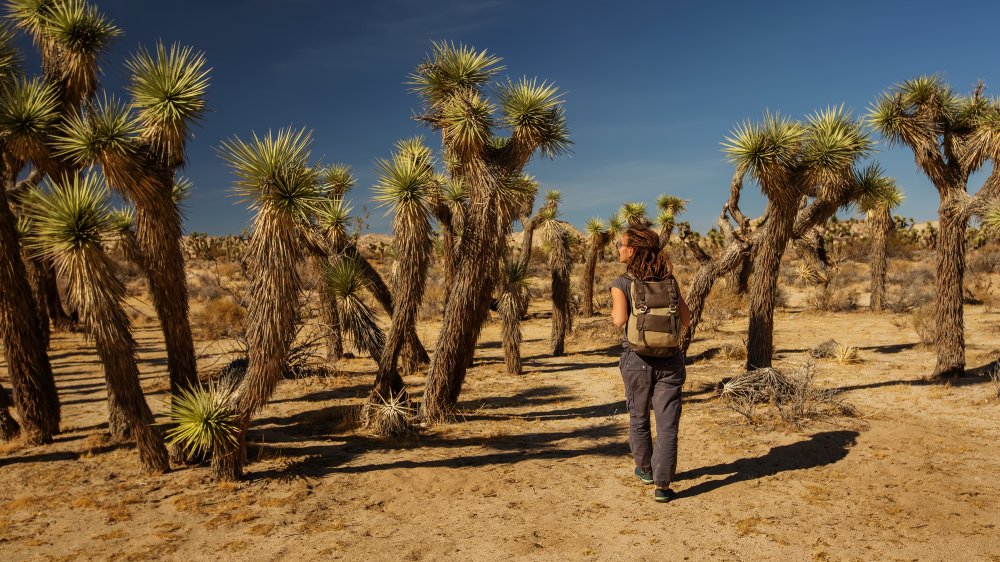The Tragic History Of Joshua Tree
Sure, Yellowstone has geysers and moose and that volcano that might actually destroy the entire planet at some point, and the Grand Canyon has that big, gaping hole in the ground that's pretty cool, but there's a lesser-known park down at the bottom of California that's got a few things to recommend it, too. Joshua Tree National Park is more than just the cover of that one U2 album — it's got death, despair, stifling heat, and a dark and sinister past. Oh, and beautiful scenery. It also has beautiful scenery
Joshua Tree is in the Mojave Desert, the only place on Earth where you'll find the giant yucca plants called "Joshua Trees." According to legend, the Mormons named these trees when they passed through the area in the mid 19th-century. They thought the twisted, eerie looking things resembled the biblical Joshua, with his arms stretched towards the promised land.
So that's all nice and religious and everything, but Joshua Tree National Park is hardly holy or devout or any of those other religiousy qualities that the Mormons were thinking about when they named the tree. The park's history is full of tragedy, and if you were superstitious you might even say the place is cursed. But you know, beautiful scenery.
Frank James got shot over gold
California's gold rush made a handful of lucky prospectors rich, but for most of the people who gave up everything in the hope of striking it rich, the Gold Rush was nothing but heartache and disappointment, and sometimes death. In 1894, a man named Frank James found gold in the hills near Jumbo Rocks, but his lucky streak was pretty short-lived. Someone — probably him — blabbed, and pretty soon he wasn't the only one who knew about the gold buried in the Mojave Desert. According to the LA Times, rumors reached an unsavory dude named Jim McHaney whose primary occupation was stealing cattle. McHaney had some of his buddies follow James back to his claim, you know, to "talk things over," but what they actually did was "talk things over" with the lucky prospector by shooting him and that was the end of Frank James' gold rush dreams. Also this was the wild wild West, so somehow McHaney ended up taking over the dead man's claim and no one thought there was an actual problem with that.
McHaney owned the mine — called "the Desert Queen" — for two years, pulling something like $30,000 to $40,000 out of it and then squandering it all and losing the claim to the bank. So it wasn't exactly eye for an eye justice or anything, but at least his ill-gotten wealth was short-lived.
Matt Riley took a wrong turn at that barrel cactus (or something)
Joshua Tree is a desert, so it's dry. It also happens to be hot, and on July 4, 1905, it was very, very hot. In a cautionary tale told by the National Park Service, Matt Riley and Henry Kitto, who really should have known better, decided to hike out from the OK Mine to the town of Mecca so they could celebrate the 4th of July with the locals. They had one canteen between them. It was no big deal, though, because Cottonwood Spring (pictured) was a mere 25 miles away, and they planned to refill when they got there. Anyway, Matt Riley and Henry Kitto were not the sharpest thorns in the desert.
About 12 miles out, Kitto started feeling not-so-great and decided to turn back. He gave the canteen to Riley and walked back to the OK Mine and lived happily ever after. Maybe. His part of the story kind of ends there. The anticipation of that 4th of July rager was evidently too much for Riley, though, who kept going. His body later was found under a bush near the road. His tracks passed within 200 yards of Cottonwood Spring, but he had evidently been so disoriented from dehydration that he didn't know how close the water actually was.
If you're feeling morbid, you can stop by Matt Riley's gravesite while you're visiting the park.
Johnny Lang died alone in the desert
Before the Joshua Tree was a national park with roads, hiking trails, and maps, it was a godforsaken desert in the middle of another godforsaken desert, and the only thing that really brought human beings into its depths was the promise of gold. But even when people did manage to find enough gold to make life in the smothering heat worthwhile, there was still the smothering heat and the part where if other gold-seekers didn't kill them, the desert might do it instead.
In the 1890s, Johnny Lang was searching for his lost horse when he sat down to rest and spotted a gold nugget on the ground. That's one of three versions of the story, anyway, and no one really knows which version is closer to the truth. According to DesertUSA, "The Lost Horse Mine" became the most successful mine in the area, and Lang himself went on to live a pretty prosperous life, though there was speculation that a big chunk of his fortune consisted of the gold he'd embezzled from business partners over the years. If that was true, the old guy pretty much got away with his crimes, right up until 1925 when he left a note on the door of his desert hut: "Gone for grub. Be back soon." Three months later a rancher named Bill Keys found Lang's mummified body in the desert, wrapped in a sleeping bag. Authorities ruled he'd died of natural causes.
Johnny Lang's mine was nearly swallowed up by a sinkhole
The desert got Johnny Lang in the end, but it wanted his mine, too. After the Joshua Tree became a national monument in 1936, the Lost Horse Mine started to fall apart. According to the National Park Service, the mill's headframe collapsed, and the nearby cabins all started to deteriorate, too. By the late 90s, the 500-foot mineshaft and each of the horizontal tunnels that branched off into the earth at 100-foot intervals also began to collapse. Earthquakes further destabilized the mine, and then a sinkhole opened up near the mill.
The National Park Service put up some concrete caps and cable netting so that the public could get an up-close look at the ruins, but even that was eventually swallowed up by the sinkhole.
As determined as the desert was, it was no match for the National Park Service — in 1996 they injected polyurethane foam into the sinkhole in an attempt to stabilize it. It worked, sort of. Park officials built a replica shaft collar and deemed the area safe for visitors, more or less. "While the Lost Horse site has been stabilized," the park's website says, "it is still not safe to walk on."
Miners would burn Joshua trees
The early American explorer John C. Fremont once called the Joshua tree "the most repulsive tree in the vegetable kingdom." That's not really fair, but Joshua trees are kind of bizarre. They're not even really trees — they're succulents, like cacti. They're odd looking things, too. They're kind of craggy, like an old man, their leaves are spiked, and they're short and dumpy — according to DesertUSA, the largest Joshua trees grow to be about 40 feet, but 15 feet is also a normal size for a mature tree. Besides their unusual looks, Joshua trees (and other types of yucca, too) also have the weird distinction of relying on a single type of moth for the survival of their entire species. Only the female pronuba moth can pollinate a yucca tree — without it, there would be no Joshua trees.
So the Joshua tree is kind of on shaky evolutionary ground anyway, but then the gold miners showed up and started cutting them down and burning them for fuel. The miners would also burn Joshua trees where they stood as signposts on dark nights. Imagine that — these trees would survive long, hot, dry seasons, year after year, only to get burned up by some dude who forgot where he parked his wagon. And it's not like the Mojave Desert is thick with Joshua trees, either — they don't grow close to each other like redwoods do, so the loss of just one of these things isn't really insignificant.
Also, cactus poaching
You've heard of poaching, of course. Elephant poaching is a big problem in Africa, and you sometimes hear about people poaching bears or bighorn sheep right here in America. But you might not know that the word "poaching" can also be used to describe illegal harvesting of plants.
In the early 20th century, cactus poaching was actually a really big problem in southern California. People liked to landscape with cacti, which makes sense because it's not exactly good practice to plant a lawn in a land without water, although try telling that to suburban Los Angeles in 2020. Anyway, according to USA Today, people used to drive out to the Joshua tree and other parts of the Mojave desert to dig up succulents like yucca and barrel cactus so they could plant a nice little drought-proof garden in their suburban yards. This wasn't just like the occasional family that was doing this, either — the problem got so bad that in some places the sheriff would post guards at popular poaching sites to try and prevent the total decimation of native plant populations. There was even an ordinance passed that prohibited the transport of desert plants on county highways, but that was about as effective as the ordinance that prevents people from transporting marijuana on public highways, so ... the poaching continued well into the 1930s, when Franklin Roosevelt signed the proclamation that made Joshua Tree a protected national monument.
Minerva Hoyt was drawn to the desert after two horrible tragedies
Minerva Hoyt is the undisputed mother of the Joshua Tree — it was her tireless campaigning to win protections for the desert that led to the establishment of the park (first a national monument) in 1936. But it was tragedy that first led Hoyt to the desert, and it was another tragedy that convinced her to come back a second time.
Hoyt found solitude in the desert after her infant son died. Shortly afterwards, Hoyt suffered a second blow — the untimely death of her husband. According to the National Park Podcast, Hoyt began spending more and more time in the desert. She grew to appreciate its strange beauty and to feel a sense of gratitude for the solace it provided after the tragic deaths of her son and husband. "During nights in the open, lying in a snug sleeping-bag, I soon learned the charm of a Joshua forest," she wrote. "This desert ... possessed me, and I constantly wished that I might find some way to preserve its natural beauty." Hoyt was appalled by the practice of cactus poaching, frequently observing the decimated landscapes that had once been full of desert plants. It was Hoyt's activism that convinced Franklin Roosevelt to establish the Joshua Tree National Monument.
Gram Parsons got cremated in the desert. Sort of.
Before U2 named their classic album after the Joshua Tree's most famous occupant, singer Gram Parsons fell in love with the desert. According to Rolling Stone, Parsons "lived hard," drinking heavily and taking opiates. Still, his sudden death in a motel room at Joshua Tree in 1973 was pretty shocking given that he was just 26-years-old.
At some point before his death, Parsons evidently told friends he wanted to be cremated in the desert, so his friends obliged. Now if you're wondering how one gets a permit to be cremated at a national monument, don't worry, his friends didn't bother with a permit. Instead, they literally stole his coffin from the Los Angeles International Airport, drug it out to a rock outcropping called Cap Rock, and set it on fire.
The whole incident was largely a way for Parsons' buddies to thumb their noses at his grieving family, who had arranged for the singer to be buried in New Orleans and had had the audacity to not invite Parsons' buddies, who were clearly stand-up citizens despite having posed as hearse drivers in order to steal a coffin with a body in it. The cremation was only partly successful, though, and the remainder of Parsons' remains were eventually buried in Metairie, LA.
Human beings have made the Joshua Tree vulnerable to fire
Deserts are dry, but the plants that grow there are pretty well-adapted to living in those dry conditions. Succulents and other desert plants store water in their tissues, so they can go a very long time between storms without drying up themselves. As a bonus, succulents are fire resistant — they're full of water, so fire doesn't tend to jump between them like it does in a woody forest. There also aren't a lot of native grasses in the Mojave, and the plants are widely spaced, so although lightning fires have always been common there, they never used to burn much more than a quarter of an acre or so because they just couldn't get the legs for large scale destruction.
According to the National Park Service, though, the number and intensity of fires in Joshua Tree National Park has been steadily increasing over the past 50 years. A 1995 fire burned more than 5,000 acres, and a 1999 fire burned nearly 14,000. How is this possible? Because non-native species now grow in the Joshua Tree, filling up the gaps between the larger native species and creating fuel to feed hotter, faster fires. And how do non-native species get to places like the Joshua Tree? People, of course. So there's that.
People are still getting lost in Joshua Tree
As the 20th century turned into the 21st century, people got smarter about respecting the desert and following safety precautions. Well, not really. Some of them did. But others continued to make the same mistakes as guys like Matt Riley. But at least no one was getting shot for their gold anymore.
In 2018, the 76-year-old David Sewell, who was legally blind, went out for a day hike in Joshua Tree National Park. According to the Los Angeles Times, he carried just two small water bottles and a sandwich.
To be fair, Sewell was an experienced hiker and he knew the park pretty well, and despite being legally blind, he could see well enough to drive a car, so it's not like he was walking around in the dark or anything. But even experienced hikers can get turned around when they're alone in the desert, and that's exactly what happened to Sewell. After collapsing from exhaustion, he managed to make a fire and make the shape of an "H" for "help" out of white rocks in the hope he'd be spotted from the air. In the end, it was vultures who led the search to him. Sewell's rescuer saw one circling above and arrived just in time to save his life.
Murders still happen in Joshua Tree, too
Deserts are great places to lose yourself, or to literally get lost, or have yourself cremated after you die of an overdose in a motel. They are also a great place to hide bodies, or at least that's what a bunch of murderous types have independently concluded over the years. In one notorious 2014 case of desert murder, the body of Erin Corwin was discovered in Joshua Tree National Park 250 feet down a mine shaft, next to the propane tank that had been thrown down there with her in an attempt to start an evidence-destroying fire.
Corwin had been murdered in the desert by Chris Lee, the man she was having an affair with. According to the New York Post, Lee lured her into the park with promises of a "special surprise," and then he strangled her and dumped her body. He wasn't super stealthy about it, either — he even got caught searching the internet for advice on body disposal.
Lee made a lot of stupid choices, but he almost succeeded at permanently hiding Corwin's body. Hundreds of searchers scoured 1,200 acres of desert wilderness for weeks without success. Then, the day the search was officially going to be called off, a caver smelled gasoline near the mouth of one of the area's mines. Corwin was found, and two years later Lee was convicted of first-degree murder.
Cold blooded murder, or mercy killing?
Most of the time, the desert prefers not to give up its secrets. When the decomposed bodies of Joseph Orbeso and Rachel Nguyen were found in Joshua Tree National Park in October of 2017, it looked like a brutal murder-suicide. But the couple had been missing for nearly three months, and based on the state of the bodies it was impossible to really know what went down before the pair actually died.
What was obvious was that Orbeso shot Nguyen, then shot himself. It wasn't at all obvious, though, what his motive was. Family members believe it was a mercy killing — the couple became lost, they said, ran out of water, and then decided to end their own lives rather than die slowly from dehydration. The scant evidence seems to support that theory. According to the Orange County Register, the bodies were found under a tree as if the pair had been seeking shade, they had no water, and they'd clearly been rationing their food. They were also just two miles from where their car was parked, which could indicate they were disoriented and had been wandering.
There was nothing else, really, that could have answered the question definitively, and we'll never really know what happened during Joseph Orbeso and Rachel Nguyen's last hours. The desert doesn't always keep its secrets, but this time it's not talking.
If you or anyone you know is having suicidal thoughts, please call the National Suicide Prevention Lifeline at 1-800-273-TALK (8255).
